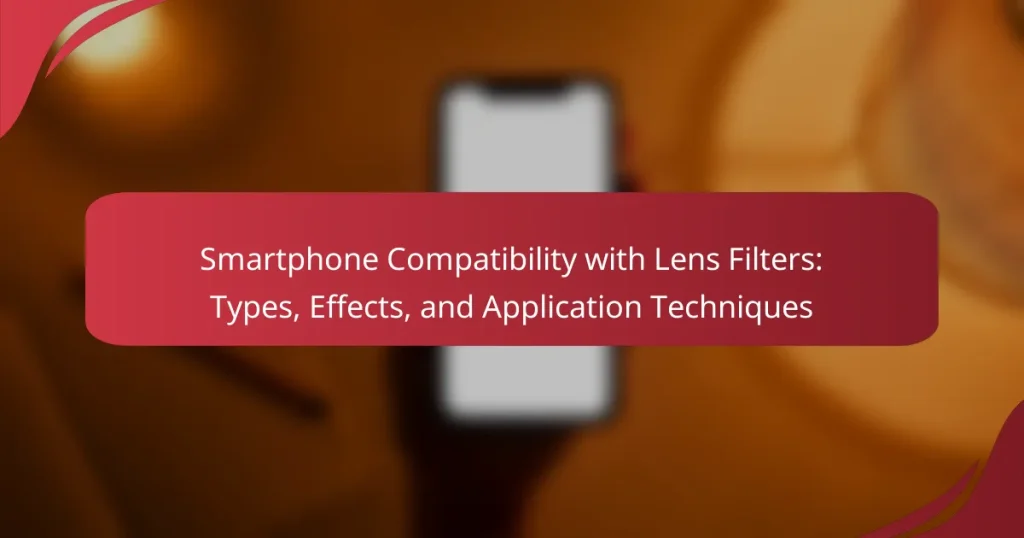Smartphone compatibility with lens filters involves the ability of smartphones to utilize external lens filters for enhancing photography. This article covers various types of lens filters, including polarizing filters, ND filters, macro filters, and UV filters, each serving distinct photographic purposes. It explains how these filters can improve image quality by enhancing colors, reducing glare, and allowing for creative effects like motion blur. Additionally, the article outlines key steps for effectively applying lens filters to smartphones, ensuring users can maximize their photography capabilities.
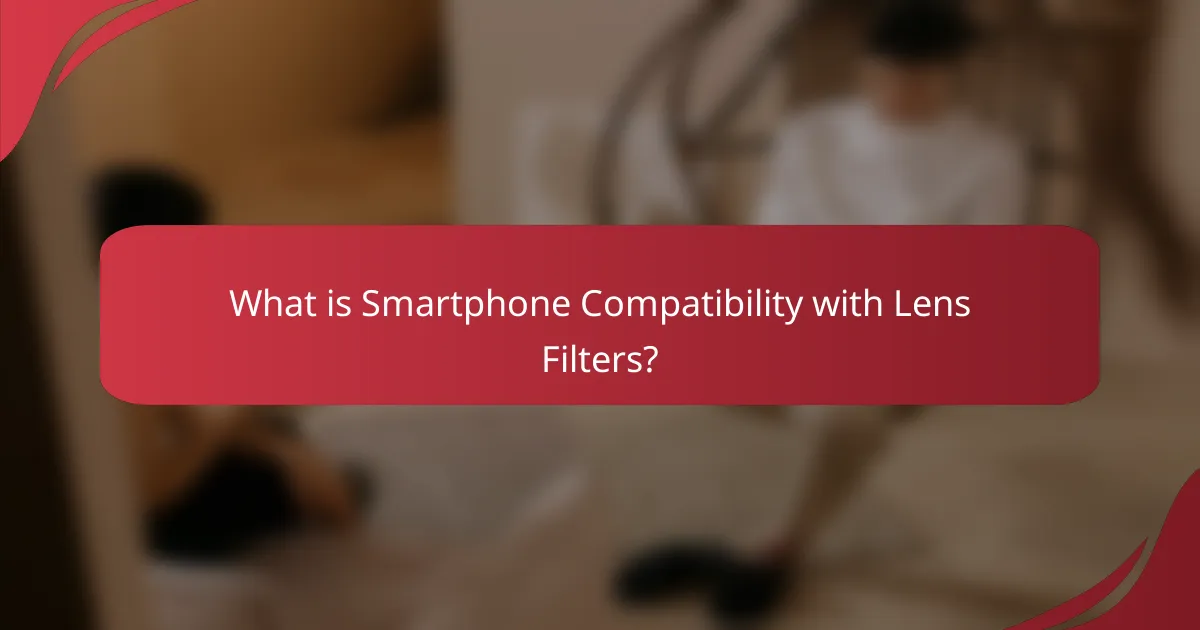
What is Smartphone Compatibility with Lens Filters?
Smartphone compatibility with lens filters refers to the ability of smartphones to use external lens filters for photography. Many smartphones have camera lenses that can accommodate various lens filters. These filters can enhance image quality, adjust colors, or reduce glare. Compatibility often depends on the smartphone’s lens size and design. Some smartphones support clip-on filters, while others may require specific cases or mounts. For example, popular brands like Moment offer lens filters designed for specific smartphone models. This compatibility allows users to expand their photography capabilities significantly.
How do lens filters enhance smartphone photography?
Lens filters enhance smartphone photography by improving image quality and creative options. They reduce glare and reflections, which leads to clearer images. Filters can also enhance colors, making them more vibrant. For instance, polarizing filters increase contrast in outdoor scenes. Additionally, filters can help manage exposure in bright conditions. They enable long exposure effects, capturing motion blur creatively. Some filters protect the lens from scratches and dust. Overall, using filters allows for greater artistic expression in smartphone photography.
What types of lens filters are available for smartphones?
There are several types of lens filters available for smartphones. These include polarizing filters, which reduce glare and reflections. Neutral density filters limit the amount of light entering the lens. UV filters protect the lens from scratches and dust. Close-up filters allow for macro photography by enabling closer focus. Color filters enhance or alter the color tones in images. Each filter serves a specific purpose in improving photographic quality.
How do different lens filters affect image quality?
Different lens filters can significantly affect image quality. Polarizing filters enhance color saturation and reduce reflections. They improve contrast in images by darkening skies and increasing detail in clouds. Neutral density filters allow for longer exposure times without overexposing images. This results in smoother water and motion blur effects. UV filters primarily protect the lens and have minimal impact on image quality. However, they can slightly reduce sharpness and contrast in certain conditions. Each filter type alters light entering the camera, thus influencing overall image characteristics.
Why is compatibility important when using lens filters on smartphones?
Compatibility is crucial when using lens filters on smartphones to ensure proper fit and functionality. A compatible filter aligns with the smartphone’s camera specifications. This alignment prevents vignetting, which can occur if the filter is too large or improperly fitted. Additionally, compatibility affects image quality by allowing optimal light transmission. Filters that do not match can introduce distortion or color shifts. Proper compatibility also ensures that the smartphone’s autofocus and other features operate effectively. This is essential for maintaining the quality of captured images. Therefore, using compatible lens filters maximizes the performance of the smartphone camera.
What factors determine smartphone compatibility with lens filters?
Smartphone compatibility with lens filters is determined by several factors. The first factor is the smartphone’s camera specifications. These include the lens diameter and focal length. The second factor is the filter type, such as polarizing, ND, or macro filters. Each filter has specific requirements for effective use. The third factor is the mounting mechanism. Some smartphones require specific cases or adapters to attach filters securely. Additionally, the smartphone’s physical design affects compatibility. For instance, protruding camera lenses may necessitate specific filter designs. Lastly, the user’s intended photography style influences filter choice and compatibility. These factors collectively determine whether a lens filter can be effectively used with a smartphone.
How can users ensure proper fit and function of lens filters?
Users can ensure proper fit and function of lens filters by selecting the correct filter size for their smartphone’s lens. Users should measure the diameter of their lens to find the appropriate filter size. Most filters have a specified diameter in millimeters. Users can refer to their smartphone’s specifications for this information.
Additionally, users should check the filter type compatible with their lens. Different filters serve various purposes, such as polarizing or ND filters. Users should also ensure that the filter attaches securely to the lens without any gaps. A secure fit prevents light leaks and maintains image quality.
Finally, users can test the filter by taking sample photos before committing to extensive use. This helps verify that the filter performs as expected in different lighting conditions.
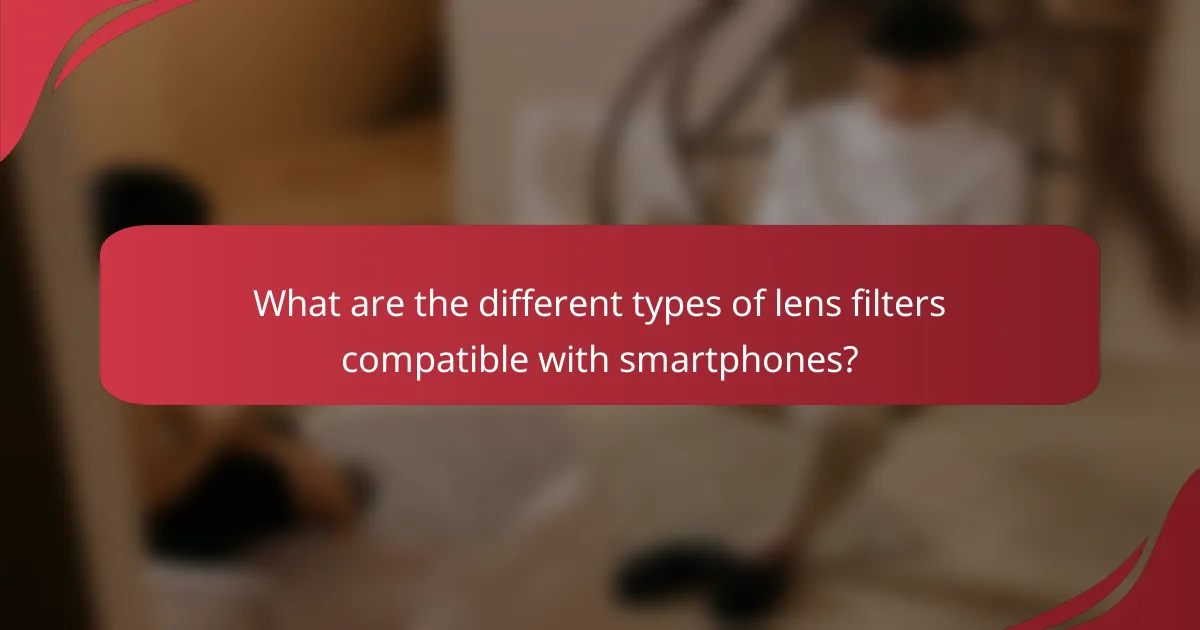
What are the different types of lens filters compatible with smartphones?
The different types of lens filters compatible with smartphones include polarizing filters, ND (neutral density) filters, macro filters, and UV filters. Polarizing filters reduce glare and reflections, enhancing color saturation. ND filters allow for longer exposure times, ideal for capturing motion blur. Macro filters enable close-up photography, revealing fine details in small subjects. UV filters protect the lens from scratches and dust, although their optical benefits are minimal with digital sensors. Each type serves specific photographic purposes, enhancing the smartphone photography experience.
What are the most common types of lens filters for smartphones?
The most common types of lens filters for smartphones include polarizing filters, ND (neutral density) filters, and macro filters. Polarizing filters reduce glare and enhance color saturation in images. ND filters limit the amount of light entering the lens, allowing for longer exposure times. Macro filters enable close-up photography by allowing the camera to focus on small subjects. Each filter serves a distinct purpose and enhances the smartphone photography experience.
How does each type of lens filter impact photo effects?
Polarizing filters reduce reflections and enhance colors. They improve contrast in skies and foliage. UV filters protect the lens without altering colors. They block UV light, preventing haziness in photos. ND filters decrease light entering the lens. They allow for longer exposures and motion blur effects. Graduated ND filters balance exposure between sky and land. They create a more evenly lit image. Close-up filters enable macro photography. They allow for detailed close-up shots of small subjects. Each filter type serves a specific purpose, enhancing overall photo quality.
What are the specific use cases for each type of lens filter?
Polarizing filters reduce glare and enhance colors. They are particularly useful for landscape photography. These filters help in capturing vivid skies and reducing reflections from water surfaces. Neutral density filters limit light entering the lens. They allow for longer exposure times in bright conditions. This is beneficial for capturing motion blur in waterfalls or clouds. UV filters protect the lens from scratches and dust. They are often used as a protective layer for the lens. Graduated filters balance exposure in scenes with bright skies and darker foregrounds. They are essential for capturing well-exposed landscapes. Close-up filters allow for macro photography. They enable photographers to focus on small subjects at close range. Each filter type serves a distinct purpose, enhancing specific photographic effects.
What should users consider when choosing lens filters for their smartphones?
Users should consider the type of lens filter compatible with their smartphone’s camera. Different filters serve various purposes, such as polarizing, UV, or ND filters. Compatibility with the smartphone’s lens size is crucial to ensure proper fit and functionality. The quality of the filter material affects image clarity and color accuracy. Users should also evaluate the filter’s ease of attachment and removal. Price and brand reputation can indicate the filter’s quality and durability. Reviews and user feedback provide insights into performance and usability. Overall, careful consideration of these factors will enhance smartphone photography.
How do smartphone specifications influence lens filter choice?
Smartphone specifications directly influence lens filter choice by determining compatibility and performance. The camera sensor size affects the type of filters that can be used. Larger sensors may require filters that provide better light transmission and color accuracy. The lens focal length influences the filter’s effect on image distortion. Smartphones with wide-angle lenses may need specific filters to avoid vignetting.
Additionally, the resolution of the camera impacts the necessity for high-quality filters. Higher resolution cameras benefit from superior optical quality in filters to maintain image clarity. The presence of image stabilization features may also dictate filter choice, as heavier filters can disrupt stabilization.
Lastly, smartphone materials and design can limit filter attachment options. Some smartphones may not support traditional filter mounts, requiring alternative solutions. Thus, understanding smartphone specifications is crucial for selecting the appropriate lens filter.
What are the price ranges and quality considerations for lens filters?
Lens filters typically range in price from $10 to $300. The price depends on the type and quality of the filter. Basic filters like UV or polarizing filters are often on the lower end. High-end filters, such as ND or specialty filters, can be significantly more expensive.
Quality considerations include the material used, optical clarity, and coating. Glass filters generally offer better quality than plastic. Multi-coated filters reduce reflections and enhance light transmission. Brands with a reputation for quality, like B+W or Hoya, often provide more reliable performance.
Investing in a higher-quality filter can improve image results and durability. Cheaper filters may introduce unwanted artifacts or reduce sharpness. Therefore, selecting a filter should balance budget and desired photographic outcomes.
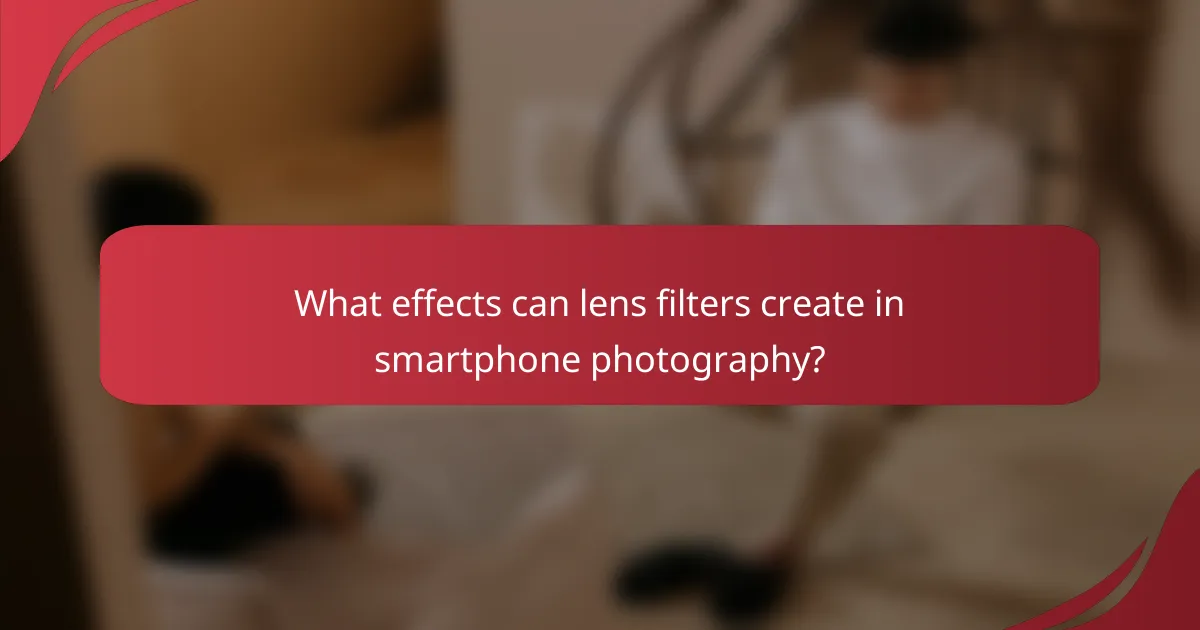
What effects can lens filters create in smartphone photography?
Lens filters can create various effects in smartphone photography. They enhance colors, reduce glare, and improve contrast. Polarizing filters minimize reflections from surfaces like water and glass. This results in clearer images of landscapes and skies. Neutral density filters allow for longer exposure times. This creates motion blur in moving subjects, like waterfalls. Close-up filters enable macro photography. They allow for detailed shots of small subjects. Each filter type serves a specific purpose, enhancing the overall photographic experience.
How do lens filters alter color and light in photographs?
Lens filters alter color and light in photographs by modifying the wavelengths of light that enter the camera. They can enhance or reduce certain colors, affecting the overall tone of the image. For example, a polarizing filter reduces glare and increases color saturation. A neutral density filter allows for longer exposure times without overexposing the image. Color filters can shift the color balance, making images warmer or cooler. These filters can also improve contrast and clarity in specific lighting conditions. The effects of these filters are widely recognized in photography, enhancing the final image quality.
What are the visual effects of using polarizing filters?
Polarizing filters enhance image quality by reducing glare and reflections. They improve color saturation, making skies bluer and foliage greener. The filters also increase contrast in images, resulting in more vivid visuals. By minimizing unwanted reflections from surfaces like water or glass, they provide clearer images. Additionally, polarizing filters can deepen the sky’s color and enhance cloud definition. They are particularly effective in landscape photography. The visual effects are most noticeable in bright, sunny conditions. Overall, polarizing filters significantly improve the clarity and vibrancy of photographs.
How do ND filters impact exposure in bright conditions?
ND filters reduce the amount of light entering the camera lens in bright conditions. This allows for longer exposure times without overexposing the image. ND filters come in various strengths, measured in stops, which indicate how much light is blocked. For example, a 3-stop ND filter reduces light by a factor of eight. This capability enables photographers to achieve desired effects, such as motion blur, even in bright sunlight. Using ND filters helps maintain proper exposure while allowing for creative control over depth of field and motion.
What are the creative applications of lens filters in smartphone photography?
Lens filters in smartphone photography enhance creativity through various applications. They can modify light, control reflections, and adjust colors. Polarizing filters reduce glare from reflective surfaces. This allows for clearer images in bright conditions. Neutral density filters enable longer exposure times. This creates motion blur effects, like flowing water. Color filters can change the mood of an image. They add warmth or coolness to photos. Graduated filters help balance exposure in high-contrast scenes. These applications expand artistic possibilities for smartphone photographers.
How can users experiment with different filters for artistic effects?
Users can experiment with different filters for artistic effects by utilizing various smartphone apps and camera settings. Many apps offer a range of filters that can be applied in real-time or post-capture. Users can adjust filter intensity to see varying effects on their images. Additionally, they can combine multiple filters for unique results. Testing filters on different subjects enhances creativity and understanding of artistic possibilities. For instance, a study by the Journal of Visual Communication found that users often achieve more dynamic images through filter experimentation. This approach encourages exploration and innovation in photography.
What tips can enhance the use of lens filters in various environments?
Utilizing lens filters effectively in various environments enhances image quality. First, choose the right filter type for your specific conditions. For instance, polarizing filters reduce glare from water and glass, improving color saturation. Neutral density filters allow for longer exposures in bright light, creating motion blur effects.
Adjust your camera settings to complement the filter used. For example, when using a polarizing filter, rotate it to find the optimal reflection reduction. Always check for vignetting, especially with wide-angle lenses, as it can occur at the edges of images.
Clean your filters regularly to avoid dust and smudges affecting image clarity. Additionally, consider the time of day for optimal lighting conditions. Golden hour often yields the best results with filters. Lastly, experiment with different filters in various environments to understand their unique effects on your photography.
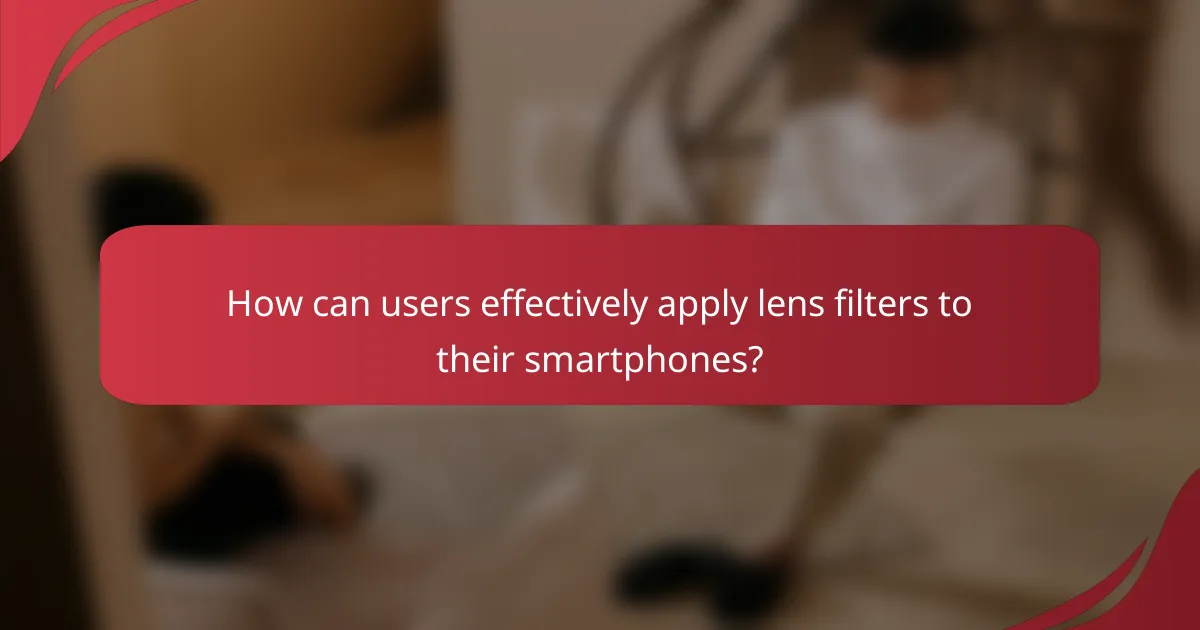
How can users effectively apply lens filters to their smartphones?
Users can effectively apply lens filters to their smartphones by following a few key steps. First, select the appropriate lens filter for the desired effect, such as polarizing or ND filters. Next, ensure that the filter is compatible with the smartphone model. Many filters attach directly to the smartphone lens or require a specific case. Clean the smartphone lens before attaching the filter to avoid any dirt or smudges. Align the filter correctly with the smartphone lens to prevent vignetting. After attachment, test the filter by taking sample photos to assess the effect. Adjust the filter position as needed for optimal results. This method enhances image quality and provides creative photographic options.
What techniques can improve the use of lens filters in photography?
Using lens filters in photography can be improved through several techniques. First, ensure proper filter attachment to avoid vignetting. Use high-quality filters to maintain image clarity and color accuracy. Adjust exposure settings when using filters to compensate for light reduction. Experiment with different filter types, such as polarizers or ND filters, for specific effects. Clean filters regularly to prevent dust and smudges from affecting image quality. Understand the filter’s impact on colors and contrast to achieve desired results. Finally, practice using filters in various lighting conditions to master their effects.
How should users clean and maintain their lens filters?
Users should clean and maintain their lens filters using a microfiber cloth and lens cleaning solution. Start by removing the filter from the lens to avoid scratches. Lightly blow off any loose dust or debris from the filter surface. Apply a few drops of lens cleaning solution to the microfiber cloth, not directly on the filter. Gently wipe the filter in a circular motion to avoid streaks. For stubborn spots, repeat the process. Store lens filters in a protective case when not in use to prevent damage. Regular maintenance keeps filters in optimal condition and ensures clear images.
What common mistakes should be avoided when using lens filters?
Common mistakes to avoid when using lens filters include improper attachment. Ensuring the filter is securely fastened prevents vignetting and image distortion. Another mistake is using the wrong type of filter for the situation. For example, a polarizing filter should not be used in low light conditions. Neglecting to clean the filter can result in reduced image quality due to dust or smudges. Additionally, stacking multiple filters can lead to excessive flare and loss of sharpness. It is also important to remember to check for color casts introduced by certain filters. Lastly, forgetting to adjust settings based on filter use can affect exposure and overall image quality.
What are some best practices for smartphone photography with lens filters?
Use lens filters to enhance smartphone photography by following specific best practices. First, select the right filter type for your needs, such as polarizing, ND, or UV filters. Polarizing filters reduce reflections and enhance colors, while ND filters allow for longer exposures without overexposing the image.
Ensure the filter is compatible with your smartphone lens size. Use a step-up ring if necessary for proper fitting. When attaching the filter, clean both the filter and lens to avoid dust and smudges.
Experiment with different angles and lighting conditions to see how the filter affects your images. Always check the camera settings to ensure optimal exposure when using filters.
Review your images to assess the filter’s impact on color and clarity. This practice ensures you understand the filter’s effects and helps refine your technique over time.
How can users maximize the benefits of lens filters in their shots?
Users can maximize the benefits of lens filters in their shots by selecting the appropriate filter type for their desired effect. For instance, a polarizing filter reduces reflections and enhances colors, making it ideal for landscape photography. ND filters allow for longer exposure times, which can create motion blur in water or clouds. Users should also ensure proper attachment to avoid vignetting or image distortion. Additionally, shooting in optimal lighting conditions can enhance the filter’s effectiveness. Regularly cleaning filters prevents dirt and smudges from affecting image quality. Understanding the specific attributes of each filter type helps users achieve their creative vision.
What resources are available for learning more about lens filter applications?
Books on photography techniques often cover lens filter applications. “The Digital Photography Book” by Scott Kelby includes practical advice. Online courses on platforms like Udemy and Coursera offer structured learning. Websites such as B&H Photo and Adorama provide detailed guides. YouTube channels like Fstoppers and Tony & Chelsea Northrup feature video tutorials. Photography forums and communities, such as Reddit’s r/photography, facilitate discussion and shared experiences. These resources collectively enhance understanding of lens filter applications.
Smartphone compatibility with lens filters is the primary focus of this article, exploring how various filters can enhance smartphone photography. Key topics include the types of lens filters available, such as polarizing, neutral density, and macro filters, along with their specific effects on image quality and creative applications. The article also discusses the importance of compatibility for optimal performance, factors determining it, and best practices for using filters effectively. Additionally, users will find guidance on selecting the right filters, maintaining them, and avoiding common mistakes to maximize their photographic outcomes.
